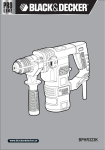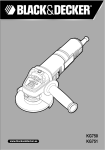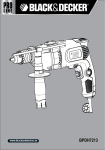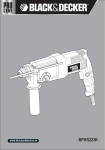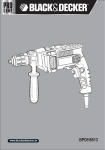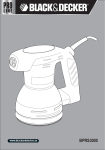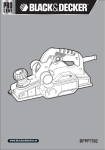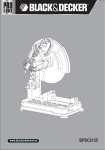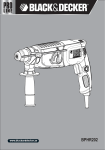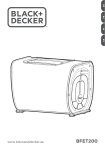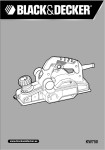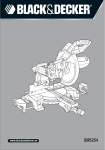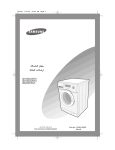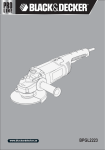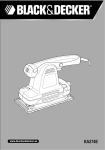Download Instruction Manual - Black & Decker Service Technical Home Page
Transcript
www.blackanddecker.ae KR703/KR704 KR753/KR803 ENGLISH 6 5 4 3 7 2 1 8 2 ENGLISH 7 8 A 12 13 9 10 B 10 11 6 C 6 D 3 ENGLISH Intended use b. Avoid body contact with earthed or grounded surfaces such as pipes, radiators, ranges Your Black & Decker impact drill has been and refrigerators. There is an increased risk designed for drilling in wood, metal, plastics, and of electric shock if your body is earthed or masonry as well as for screwdriving purposes. grounded. This tool is intended for consumer use only. c. Do not expose power tools to rain or wet Safety instructions conditions. Water entering a power tool will increase the risk of electric shock. General power tool safety warnings Save all warnings and instructions for future reference. d. Do not abuse the cord. Never use the cord for carrying, pulling or unplugging the power tool. Keep cord away from heat, oil, sharp edges or moving parts. Damaged or entangled cords increase the risk of electric shock. The term "power tool" in all of the warnings listed below refers to your mains operated (corded) power tool or battery operated (cordless) power tool. e. When operating a power tool outdoors, use an extension cord suitable for outdoor use. Use of a cord suitable for outdoor use reduces the risk of electric shock. 1. Work area safety f. If operating a power tool in a damp location is unavoidable, use a residual current device (RCD) protected supply. Use of an RCD reduces the risk of electric shock. Warning! Read all safety warnings and all instructions. Failure to follow the warnings and instructions listed below may result in electric shock, fire and/or serious injury. a. Keep work area clean and well lit. Cluttered or dark areas invite accidents. b. Do not operate power tools in explosive atmospheres, such as in the presence of flammable liquids, gases or dust. Power tools create sparks which may ignite the dust or fumes. c. Keep children and bystanders away while operating a power tool. Distractions can cause you to lose control. 2. Electrical safety 3. Personal safety a. Stay alert, watch what you are doing and use common sense when operating a power tool. Do not use a power tool while you are tired or under the influence of drugs, alcohol or medication. A moment of inattention while operating power tools may result in serious personal injury. b. Use personal protective equipment. Always a. Power tool plugs must match the outlet. wear eye protection. Protective equipment Never modify the plug in any way. Do not use such as dust mask, non-skid safety shoes, any adapter plugs with earthed (grounded) hard hat, or hearing protection used for power tools. Unmodified plugs and matching appropriate conditions will reduce personal outlets will reduce risk of electric shock. injuries. 4 ENGLISH c. Prevent unintentional starting. Ensure the switch is in the off-position before connecting to power source and/or battery pack, picking up or carrying the tool. Carrying power tools with your finger on the switch or energising power tools that have the switch on invites accidents. d. Remove any adjusting key or wrench before turning the power tool on. A wrench or a key left attached to a rotating part of the power tool may result in personal injury. e. Do not overreach. Keep proper footing and balance at all times. This enables better control of the power tool in unexpected situations. f. Dress properly. Do not wear loose clothing or jewellery. Keep your hair, clothing and gloves away from moving parts. Loose clothes, jewellery or long hair can be caught in moving parts. c. Disconnect the plug from the power source and/or the battery pack from the power tool before making any adjustments, changing accessories, or storing power tools. Such preventive safety measures reduce the risk of starting the power tool accidentally. d. Store idle power tools out of the reach of children and do not allow persons unfamiliar with the power tool or these instructions to operate the power tool. Power tools are dangerous in the hands of untrained users. e. Maintain power tools. Check for misalignment or binding of moving parts, breakage of parts and any other condition that may affect the power tools operation. If damaged, have the power tool repaired before use. Many accidents are caused by poorly maintained power tools. f. Keep cutting tools sharp and clean. Properly maintained cutting tools with sharp cutting edges are less likely to bind and are easier to control. g. If devices are provided for the connection of dust extraction and collection facilities, ensure these are connected and properly used. Use of dust collection can reduce dust-related hazards. g. Use the power tool, accessories and tool bits etc., in accordance with these instructions, taking into account the working conditions and the work to be performed. Use of the power tool for operations different from those intended could result in a hazardous situation. 4. Power tool use and care 5. Service a. Do not force the power tool. Use the correct power tool for your application. The correct power tool will do the job better and safer at the rate for which it was designed. a. Have your power tool serviced by a qualified repair person using only identical replacement parts. This will ensure that the safety of the power tool is maintained. b. Do not use the power tool if the switch does not turn it on and off. Any power tool that cannot be controlled with the switch is dangerous and must be repaired. Additional power tool safety warnings Additional safety warnings for drills and impact drills 5 ENGLISH • Wear ear protectors with impact drills. Exposure to noise can cause hearing loss. • Use auxiliary handles supplied with the tool. Loss of control can cause personal injury. • Hold power tool by insulated gripping surfaces when performing an operation where the cutting accessory may contact hidden wiring or its own cord. Cutting accessory contacting a "live" wire may make exposed metal parts of the power tool "live" and shock the operator. • Use clamps or another practical way to Vibration The declared vibration emission values stated in the technical data and the declaration of conformity have been measured in accordance with a standard test method provided by EN 60745 and may be used for comparing one tool with another. The declared vibration emission value may also be used in a preliminary assessment of exposure. Warning! The vibration emission value during actual use of the power tool can differ from the declared value depending on the ways in which the tool is used. The vibration level may increase above the level stated. secure and support the workpiece to a stable platform. Holding the work by hand or against your body leaves it unstable and may When assessing vibration exposure to lead to loss of control. determine safety measures required by Before drilling into walls, floors or ceilings, 2002/44/EC to protect persons regularly using check for the location of wiring and pipes. power tools in employment, an estimation of Avoid touching the tip of a drill bit just after vibration exposure should consider, the actual drilling, as it may be hot. conditions of use and the way the tool is used, including taking account of all parts of the This tool is not intended for use by persons operating cycle such as the times when the tool (including children) with reduced physical, is switched off and when it is running idle in sensory or mental capabilities, or lack of experience and knowledge, unless they have addition to the trigger time. • • • been given supervision or instruction concerning use of the appliance by a person responsible for their safety. Children should be supervised to ensure that they do not play with the appliance. • The intended use is described in this Labels on tool The following pictograms are shown on the tool: Warning! To reduce the risk of injury, the user must read the instruction manual. instruction manual. The use of any accessory Electrical safety or attachment or performance of any This tool is double insulated; therefore operation with this tool other than those recommended in this instruction manual may no earth wire is required. Always check present a risk of personal injury and/or that the power supply corresponds to the voltage damage to property. on the rating plate. 6 ENGLISH • If the supply cord is damaged, it must be replaced by the manufacturer or an authorised Black & Decker Service Centre in order to avoid a hazard. Fitting a drill bit or screwdriver bit (fig. B & C) Keyless chuck with spindle lock (fig. B) Features • Open the chuck by turning the sleeve (9) This tool includes some or all of the following features. • Insert the bit shaft (10) into the chuck. • Tighten the chuck by turning the sleeve 1. Variable speed switch counterclockwise. clockwise. 2. Lock-on button Keyed chuck (fig. C) 3. Variable speed control switch • Open the chuck by turning the sleeve (11) 4. Forward/reverse slider 5. Drilling mode selector 6. Chuck 7. Depth stop 8. Side handle Assembly Warning! Before assembly, make sure that the tool is switched off and unplugged. Fitting the side handle and depth stop (fig. A) • Turn the grip counterclockwise until you can slide the side handle (8) onto the front of the tool as shown. • Rotate the side handle into the desired position. • Insert the depth stop (7) into the mounting hole as shown. • Set the drilling depth as described below. • Tighten the side handle by turning the grip clockwise. counterclockwise. • Insert the bit shaft (10) into the chuck. • Insert the chuck key (12) into each hole (13) in the side of the chuck and turn clockwise until tight. Removing and refitting the chuck (fig. D) • Open the chuck as far as possible. • Remove the chuck retaining screw, located in the chuck, by turning it clockwise using a screwdriver. • Tighten an Allen key into the chuck and strike it with a hammer as shown. • Remove the Allen key. • Remove the chuck by turning it counterclockwise. • To refit the chuck, screw it onto the spindle and secure it with the chuck retaining screw. Residual risks. Additional residual risks may arise when using the tool which may not be included in the enclosed safety warnings. These risks can arise from misuse, prolonged use etc. 7 ENGLISH Even with the application of the relevant safety regulations and the implementation of safety devices, certain residual risks can not be avoided. These include: Selecting the drilling mode • Injuries caused by touching any • For drilling in other materials and for rotating/moving parts. • Injuries caused when changing any parts, blades or accessories. • Injuries caused by prolonged use of a tool. When using any tool for prolonged periods ensure you take regular breaks. • Impairment of hearing. • Health hazards caused by breathing dust developed when using your tool (example:working with wood, especially oak, beech and MDF.) • For drilling in masonry, set the drilling mode selector (5) to the position. screwdriving, set the drilling mode selector (5) to the position. Setting the drilling depth (fig. A) • Slacken the side handle (8) by turning the grip counterclockwise. • Set the depth stop (7) to the desired position. The maximum drilling depth is equal to the distance between the tip of the drill bit and the front end of the depth stop. • Tighten the side handle by turning the grip clockwise. Use Switching on and off Warning! Let the tool work at its own pace. Do not overload. • To switch the tool on, press the variable Warning! Before drilling into walls, floors or ceilings, check for the location of wiring and pipes. Selecting the direction of rotation For drilling and for tightening screws, use forward (clockwise) rotation. For loosening screws or removing a jammed drill bit, use reverse (counterclockwise) rotation. • To select forward rotation, push the forward/reverse slider (4) to the left. • To select reverse rotation, push the forward/reverse slider to the right. Warning! Never change the direction of rotation while the motor is running. 8 speed switch (1). The tool speed depends on how far you press the switch. If the tool has a variable speed control knob (3), set it to the required speed range. As a general rule, use low speeds for large diameter drill bits and high speeds for smaller diameter drill bits. • For continuous operation, press the lock-on button (2) and release the variable speed switch. This option is available only at full speed or at any speed preset with the variable speed control knob (3). This option does not work in reverse rotation. • To switch the tool off, release the variable speed switch. To switch the tool off when in continuous operation, press the variable speed switch once more and release it. ENGLISH Accessories The performance of your tool depends on the accessory used. Black & Decker and Piranha accessories are engineered to high quality standards and designed to enhance the performance of your tool. By using these accessories you will get the very best from your tool. Maintenance Your tool has been designed to operate over a long period of time with a minimum of maintenance. Continuous satisfactory operation depends upon proper tool care and regular cleaning. Warning! Before performing any maintenance, switch off and unplug the tool. • Regularly clean the ventilation slots in your Follow the fitting instructions supplied with good quality plugs. Any replacement fuse must be of the same rating as the original fuse supplied with the product. Technical Data KR703 KR704 Typ. 2 Typ. 1 Input voltage VAC Power input W No-load speed min-1 710 0-3,100 0-3,100 Steel/concrete mm 13/16 13/16 Wood mm 32 32 Weight kg 2.11 2.11 KR753 KR803 Typ. 2 Typ. 1 • Regularly clean the motor housing using a Mains Plug Replacement 710 Max drilling capacity tool using a soft brush or dry cloth. damp cloth. Do not use any abrasive or solvent-based cleaner. 220-240 220-240 Input voltage VAC Power input W No-load speed min-1 220-240 220-240 750 800 0-3,100 0-3,100 If a new mains plug needs to be fitted: Max drilling capacity • Safely dispose of the old plug. Steel/concrete mm 13/16 13/16 • Connect the brown lead to the live terminal of Wood mm 32 32 Weight kg 2.11 2.11 the new plug. • Connect the blue lead to the neutral terminal. • If the product is class l (earthed), connect the green / yellow lead to the earth terminal. Warning! If your product is class ll double insulated (only 2 wires in the cord set), no connection is to be made to the earth terminal. 9 ENGLISH Protecting the environment Warranty Decker product needs replacement, or if it is of If a Black & Decker product becomes defective due to a material or manufacturing defect , within 12 months from the date of purchase, Black & Decker guarantees to replace defective parts or replace such products to ensure minimum inconvenience to the customer unless: no further use to you, do not dispose of it with • The product has been subjected to misuse or Separate collection. This product must not be disposed of with normal household waste. Should you find one day that your Black & other household waste. Make this product available for separate collection. • Black & Decker provides a facility for recycling Black & Decker products once they have reached the end of their working life. This service is provided free of charge. To take advantage of this service please return your product to any authorised repair agent who will collect them on our behalf. • You can check the location of your nearest authorised repair agent by contacting your local Black & Decker office at the address indicated in this manual. Alternatively, a list of authorized Black & Decker repair agents and full details of our after-sales service and contact are available on the Internet at: www.2helpU.com. 10 neglect. • The product has sustained damage through foreign objects, substances or accidents. • Repairs have been attempted by persons other than authorised repair agents or Black & Decker service staff. To claim on the warranty, you will need to submit proof of purchase to the seller or an authorised repair agent. You can check the location of your nearest authorised repair agent by contacting your local Black & Decker office at the address indicated in this manual. Alternatively, a list of authorised Black & Decker repair agents and full details of our after-sales service and contacts are available on the Internet at: www.2helpU.com. Please visit our website www.blackanddecker.ae to register your new Black & Decker product and to be kept up to date on new products and special offers. Further information on the Black & Decker brand and our range of products is available at www.blackanddecker.ae. ARABIC 6 5 4 3 7 2 1 8 11 ARABIC 7 8 A 12 13 9 10 B D 12 10 11 6 C 6 ARABIC Ö«HÉfC’G πãe á°VQDƒŸG í£°SCÓd º°ù÷G á°ùeÓe ÖæŒ .Ü ô£N OGOõj .äÉLÓãdGh óbGƒŸGh ICÉaóŸG Iõ¡LCGh .É°VQD k ƒe ∂ª°ùL ¿Éc GPEG á«FÉHô¡c áeó°üH ∂àHÉ°UEG .áÑWôdG AGƒLC’G hCG ô£ª∏d á«FÉHô¡µdG Iõ¡LC’G ¢Vô©J ’ .ê IOÉjR ¤EG »FÉHô¡µdG RÉ¡é∏d AÉŸG π∏îJ …ODƒj ±ƒ°S .á«FÉHô¡c áeó°üH áHÉ°UE’G ô£N ’ .»FÉHô¡µdG QÉ«àdG ∂∏°S ∫ɪ©à°SG IAÉ°SEG ΩóY »¨Ñæj .O RÉ¡÷G πª◊ »FÉHô¡µdG QÉ«àdG ∂∏°S Ék≤∏£e Ωóîà°ùJ ®ÉØàM’G »¨Ñæj .QÉ«àdG øY π°üa hCG Öë°S hCG »FÉHô¡µdG hCG âjõdG hCG IQGô◊G øY Gók «©H »FÉHô¡µdG QÉ«àdG ∂∏°ùH ∑Ó°SC’G ójõJ .ácôëàŸG AGõLC’G hCG IOÉ◊G ±Gƒ◊G áeó°üH áHÉ°UE’G ô£N øe áµHÉ°ûàŸG hCG áØdÉàdG .á«FÉHô¡c Ωóîà°SG ,≥∏£dG AGƒ¡dG ‘ »FÉHô¡µdG RÉ¡÷G 𫨰ûJ óæY .g .≥∏£dG AGƒ¡dG ‘ ΩGóîà°SÓd Ö°SÉæe π«°UƒJ ∂∏°S ‘ ΩGóîà°SÓd Ö°SÉæe »FÉHô¡c QÉ«J ∂∏°S ΩGóîà°SG .á«FÉHô¡c áeó°üd ¢Vô©àdG ô£N øe π∏≤j ≥∏£dG AGƒ¡dG ¿Éµe ‘ »FÉHô¡µdG RÉ¡÷G 𫨰ûJ ÖæŒ Qò©J GPEG .h QÉ«àdG øe ájÉbh RÉ¡L ΩGóîà°SG »¨Ñæj ¬fEÉa ,ÖWQ »≤ÑàŸG QÉ«àdG øe ájÉbƒdG RÉ¡L ΩGóîà°SG π∏≤j .»≤ÑàŸG .á«FÉHô¡c áeó°üH áHÉ°UE’G ô£N øe á«°üî°ûdG áeÓ°ùdG .3 ΩGóîà°S’G ¢VôZ Ö°ûÿG Ö≤ãd ºª°üe ôµjO ófCG ∑ÓH »eó°üdG ÜÉ≤ãŸG ¢VGôZCG øY Ók °†a ,ÊÉÑŸG ¿GQóLh ∂«à°SÓÑdGh ¿OÉ©ŸGh .§≤a ∂∏¡à°ùŸG ΩGóîà°S’ ºª°üe RÉ¡÷G Gòg .»ZGÈdG ™aO áeÓ°ùdG äGOÉ°TQEG á«FÉHô¡µdG Iõ¡LC’G áeÓ°S ¢Uƒ°üîH áeÉ©dG äGôjòëàdG áeÓ°ùdG äGôjò– áaÉc IAGôb »¨Ñæj !ôjò– áaÉc ´ÉÑJG ΩóY ÖÑ°ùàj ób .äGOÉ°TQE’G áaÉch ‘ √ÉfOCG IOQGƒdG äGOÉ°TQE’Gh äGôjòëàdG ¢Vô©àdG hCG/h ≥jôM ܃°ûfh á«FÉHô¡c áeó°üH áHÉ°UE’G .IÒ£N áHÉ°UE’ ´ƒLô∏d äGOÉ°TQE’Gh äGôjòëàdG áaɵH ®ÉØàM’G ≈Lôj .Ók Ñ≤à°ùe É¡«dEG äGôjòëàdG áaÉc ‘ OQGƒdG "»FÉHô¡c RÉ¡L" í∏£°üŸG πª©j …òdG »FÉHô¡µdG RÉ¡÷G ¤EG Ò°ûj √ÉfOCG IQƒcòŸG …òdG »FÉHô¡µdG RÉ¡÷G hCG (É«k µ∏°S) »FÉHô¡µdG QÉ«àdÉH .(É«k µ∏°S’) ájQÉ£ÑdÉH πª©j πª©dG á≤£æe áeÓ°S .1 ø°ùMh πª©dG á≤£æe áaɶf ≈∏Y ®ÉØ◊G »¨Ñæj .CG ‘ áª∏¶ŸG hCG á¶àµŸG ≥WÉæŸG ÖÑ°ùàJ .É¡JAÉ°VEG .çOGƒM ´ƒbh º«∏°ùdG ¢ù◊G Ωóîà°SGh ¬∏©ØH Ωƒ≤J Ée ÖbGQh É k¶≤j øc .CG Ωóîà°ùJ ’ .»FÉHô¡µdG RÉ¡÷G 𫨰ûàH Ωƒ≤J ÉeóæY πãe ;ájQÉéØfG AGƒLCG ‘ á«FÉHô¡µdG Iõ¡LC’G π¨°ûJ ’ .Ü ÒKCÉJ â– hCG Ékµ¡æe ¿ƒµJ ÉeóæY »FÉHô¡µdG RÉ¡÷G hCG äGRÉZ hCG ∫É©à°TÓd á∏HÉb πFGƒ°S OƒLh ‘ É¡∏«¨°ûJ ÖÑ°ùàJ ób .AGhódG hCG á«dƒëµdG äÉHhöûŸG hCG ÒbÉ≤©dG …ODƒj ób QöT É¡æY èàæj á«FÉHô¡µdG Iõ¡LC’G .QÉÑZ ‘ á«FÉHô¡µdG Iõ¡LC’G 𫨰ûJ AÉæKCG á∏بdG øe á¶◊ .áæNOC’G hCG QÉѨdG ∫É©°TEG ¤EG .á¨dÉH á«°üî°T áHÉ°UEG çhóM RÉ¡÷G 𫨰ûJ AÉæKCG IQÉŸGh ∫ÉØWC’G OÉ©HEG »¨Ñæj .ê m¥Gh ÉehO k …óJQG .á«°üî°ûdG ájÉbƒdG äGó©e Ωóîà°SG .Ü Iô£«°ù∏d ∂fGó≤a ‘ AÉ¡dE’G ÖÑ°ùàj ób .»FÉHô¡µdG äÉeɪc πãe ájÉbƒdG äGó©e ΩGóîà°SG π∏≤j ±ƒ°S .Ú©∏d .RÉ¡÷G ≈∏Y áÑ∏°üdG á©Ñ≤dGh ≥∏Mõà∏d á©fÉŸG ájòMC’Gh áHôJC’G .á«°üî°T äÉHÉ°UEG çhóM ô£N øe ™ª°ùdG »bGhh á«FÉHô¡µdG áeÓ°ùdG .2 ¿CG øe ócCÉJ .Oƒ°ü≤ŸG ÒZ 𫨰ûàdG AóH ™æe Ú©àj .ê QÉ«àdG Qó°üe ™e »FÉHô¡µdG QÉ«àdG ¢ùHGƒb ≥aGƒJ Ωõ∏j .CG QÉ«àdG Qó°üà π«°UƒàdG πÑb ≥∏¨dG ™°Vh ‘ ìÉàØŸG ,á≤jôW ájCÉH ¢ùHÉ≤dG πjó©J Ék≤∏£e ÖæŒ .»FÉHô¡µdG πªM hCG ™aQ hCG äÉjQÉ£ÑdG IóMh hCG/h »FÉHô¡µdG .á°VQDƒŸG Iõ¡LC’G ™e ÅjÉ¡e ¢ùHGƒb ájCG Ωóîà°ùJ ’h ™HÉ°UC’Gh á«FÉHô¡µdG Iõ¡LC’G πªM …ODƒj .RÉ¡÷G QÉ«àdG QOÉ°üeh ádó©ŸG ÒZ ¢ùHGƒ≤dG …ODƒJ ±ƒ°S á«FÉHô¡µdG Iõ¡LC’G πªM hCG ,ìÉàØŸG ≈∏Y áYƒ°Vƒe áeó°üd ¢Vô©àdG ô£N π«∏≤J ¤EG á≤aGƒàŸG »FÉHô¡µdG .çOGƒM ´ƒbh ¤EG ,𫨰ûàdG ™°Vh ‘ ¿ƒµJ »àdG ᣰûædG .á«FÉHô¡c 13 ARABIC øY Gók «©H áeóîà°ùŸG ÒZ á«FÉHô¡µdG Iõ¡LC’G ßØMG .O øjOÉà©ŸG ÒZ ¢UÉî°TCÓd íª°ùJ ’h ∫ÉØWC’G ∫hÉæàe ≈∏Y Ú©∏£ŸG ÒZ hCG »FÉHô¡µdG RÉ¡÷G ΩGóîà°SG ≈∏Y Iõ¡LC’G .»FÉHô¡µdG RÉ¡÷G 𫨰ûàH äGOÉ°TQE’G √òg Úeóîà°ùe ój ‘ ¿ƒµJ ÉeóæY Gô£N k πµ°ûJ á«FÉHô¡µdG .ÚHQóe ÒZ RÉ¡÷G ¢üëaG .á«FÉHô¡µdG Iõ¡LC’G áfÉ«°U »¨Ñæj .g ácôM ¥ƒ©J »àdG hCG áÑ«©ŸG AGõLC’G ≈∏Y ±ô©à∏d AGõLC’G øe √ƒ∏N øe ócCÉà∏dh ácôëàŸG AGõLC’G IAÉØc ≈∏Y ôKDƒJ ób iôNCG ádÉM …CG øeh IQƒ°ùµŸG ,∞∏J …CG ≈∏Y Qƒã©dG ” GPEG .á«FÉHô¡µdG Iõ¡LC’G 𫨰ûJ ™≤J .ΩGóîà°S’G πÑb »FÉHô¡µdG RÉ¡÷G ìÓ°UEG »¨Ñæj Iõ¡LC’G áfÉ«°U Aƒ°S áé«àf çOGƒ◊G øe Òãc .á«FÉHô¡µdG 𫨰ûJ πÑb …õ«∏‚EG ìÉàØe hCG …OÉY ìÉàØe …CG ∫RCG .O Ék`≤∏©àe ìÉàØŸG ∑ôJ ÖÑ°ùàj ób .»FÉHô¡µdG RÉ¡÷G áHÉ°UEG çhóM ‘ »FÉHô¡µdG RÉ¡÷G øe QGhódG Aõ÷ÉH .á«°üî°T ≈∏Y ®ÉØ◊G »¨Ñæj . .•ôØŸG ÜGÎb’G ÖæŒ »¨Ñæj .g ∂æµÁ Gò¡a .äÉbhC’G áaÉc ‘ ¿GõJ’Gh Úeó≤dG äÉÑK ‘ »FÉHô¡µdG RÉ¡÷G ≈∏Y Ió«÷G Iô£«°ùdG øe .á©bƒàŸG ÒZ ∞bGƒŸG ¢ùHÓŸG …óJôJ ’ .áÑ°SÉæŸG ¢ùHÓŸG AGóJQG »¨Ñæj .h ∑ô©°T ≈∏Y ®ÉØ◊G »¨Ñæj .äGôgƒéŸG hCG á°VÉØ°†ØdG ób .ácôëàŸG AGõLC’G øY Gók «©H ∂JGRÉØbh ∂°ùHÓeh ô©°ûdG hCG äGôgƒéŸG hCG á°VÉØ°†ØdG ¢ùHÓŸG ≥∏©J .ácôëàŸG AGõLC’ÉH πjƒ£dG êGôîà°SG ¢Uƒ°üîH Iôaƒe Iõ¡LCG ∑Éæg âfÉc GPEG .R IOÉM ádÉM ‘ ™£≤dG äGhOCG ≈∏Y ®ÉØ◊G »¨Ñæj .h Iõ¡LC’G ∂∏J π«°UƒJ øe ócCÉJ ,™ª÷G ≥aGôeh QÉѨdG Ö°SÉæe πµ°ûH É¡«∏Y ßaÉëŸG ™£≤dG äGhOCG .áØ«¶fh ΩGóîà°SG π∏≤j ¿CG øµÁ .Ö°SÉæŸG πµ°ûdÉH É¡eGóîà°SGh á°VôY πbCG »g IOÉM á©WÉb äGôØ°ûH IOhõŸGh .QÉѨdÉH á£ÑJôŸG ôWÉîŸG çhóM øe Iõ¡LC’G ∂∏J .ºµëàdG ‘ π¡°SCGh ∫É£YCÓd ¬H ájÉæ©dGh »FÉHô¡µdG RÉ¡÷G ΩGóîà°SG .4 ¬FGõLCGh ¬JÉ≤ë∏eh »FÉHô¡µdG RÉ¡÷G ΩGóîà°SG »¨Ñæj .R ±hôX òNCG ™e ,äGOÉ°TQE’G √ò¡d Ék≤ah ∂dP ¤EG Éeh ¢VôZ ‘ »FÉHô¡µdG RÉ¡÷G ΩGóîà°SG ÖæŒ Ú©àj .CG ÖÑ°ùàj ób .QÉÑàY’G ‘ √ò«ØæJ OGôŸG πª©dGh πª©dG Ö°SÉæŸG »FÉHô¡µdG RÉ¡÷G Ωóîà°SG .Ö°SÉæe ÒZ 𫨰ûJ äÉ«∏ªY πLCG øe »FÉHô¡µdG RÉ¡÷G ΩGóîà°SG RÉ¡÷G Ωƒ≤j ±ƒ°S .√ójôJ …òdG ΩGóîà°S’Gh ¢Vô¨∏d çhóM ‘ IOƒ°ü≤ŸG 𫨰ûàdG äÉ«∏ªY øY áØ∏àfl ÌcCGh π°†aCG πµ°ûH πª©dG AGOCÉH í«ë°üdG »FÉHô¡µdG .ôWÉfl .¬∏LCG øe ¬ª«ª°üJ ” …òdG ∫ó©ŸÉH Éfk ÉeCG áfÉ«°üdG .5 ᣰSGƒH »FÉHô¡µdG RÉ¡÷G ìÓ°UEGh áfÉ«°U »¨Ñæj .CG Gòg .§≤a á≤HÉ£e QÉ«Z ™£b ΩGóîà°SÉH πgDƒe ¢üî°T .»FÉHô¡µdG RÉ¡÷G áeÓ°S ≈∏Y ®ÉØ◊G øª°†«°S Iõ¡LC’G áeÓ°S ¢Uƒ°üîH á«aÉ°VEG äGôjò– á«FÉHô¡µdG h ÖbÉãŸG áeÓ°S ¢Uƒ°üîH á«aÉ°VEG äGôjò– á«eó°üdG ÖbÉãŸG 14 ìÉàØŸG º≤j ⁄ kGPEG »FÉHô¡µdG RÉ¡÷G Ωóîà°ùJ ’ .Ü øµÁ ’ »FÉHô¡c RÉ¡L …CG .¬∏«¨°ûJ ±É≤jEGh ¬∏«¨°ûàH »¨Ñæjh Gô£N k ¿ƒµj ìÉàØŸG ΩGóîà°SÉH ¬«a ºµëàdG .¬MÓ°UEG QÉ«àdG Qó°üe øY »FÉHô¡µdG RÉ¡÷G ¢ùHÉb π°üaG .ê ájCG AGôLEG πÑb äÉjQÉ£ÑdG IóMh øY hCG/h »FÉHô¡µdG ‘ äÉ≤ë∏e ájCG Ö«côJ hCG äGÒ«¨J hCG äÓjó©J äGAGôLEG π∏≤J .É¡æjõîJ hCG á«FÉHô¡µdG Iõ¡LC’G RÉ¡÷G 𫨰ûJ AóH ô£N øe √òg á«FÉbƒdG áeÓ°ùdG .ó°üb ¿hO ICÉéa »FÉHô¡µdG ARABIC RGõàg’G .á«eó°üdG ÖbÉãŸG ΩGóîà°SG óæY ¿PC’G äÉ«bGh …óJQG • ¿Gó≤a ‘ AÉ°Vƒ°†∏d ¢Vô©àdG ÖÑ°ùàj ¿CG øµÁ å«M .™ª°ùdG á«æØdG äÉfÉ«ÑdG ‘ IQƒcòŸG áæ∏©ŸG äGRGõàg’G çÉ©ÑfG º«b á«°SÉ«b QÉÑàNG á≤jô£d Ék≤ah É¡°SÉ«b ” ≥aGƒàdG äÉeƒ∏©eh øµÁ .RÉ¡÷G ™e IOQƒŸG á«aÉ°VE’G ¢†HÉ≤ŸG Ωóîà°SG øµÁh EN 60745 QÉ«©ŸG ÖLƒÃ É¡«∏Y ¢Uƒ°üæe .á«°üî°ûdG áHÉ°UE’G ‘ ÖÑ°ùàj ¿CG Iô£«°ùdG ¿Gó≤Ød ᪫b ΩGóîà°SG øµÁh .ôNBG ™e Ée RÉ¡L áfQÉ≤Ÿ É¡eGóîà°SG í£°SCG …P ¢†Ñ≤e ᣰSGƒH »FÉHô¡µdG RÉ¡÷G ∂°ùeG .¢Vô©à∏d ‹hCG º««≤J AGôLEG ‘ áæ∏©ŸG äGRGõàg’G çÉ©ÑfG ¢ùeÓJ ób ,Ée á«∏ªY ò«ØæàH Ωƒ≤J Éeóæ©a ,ádhõ©e RÉ¡÷G ∂∏°S hCG á«ØîŸG ∑Ó°SC’G áµÑ°T ™£≤dG IóMh ΩGóîà°S’G AÉæKCG äGRGõàg’G çÉ©ÑfG ᪫b ∞∏àîJ ób !ôjò– QÉ«J ∂∏°ùd ™£≤dG IóMh á°ùeÓe …ODƒJ óbh .¬°ùØf ∞bƒàj å«M áæ∏©ŸG ᪫≤dG øY »FÉHô¡µdG RÉ¡é∏d »∏©ØdG "»◊G" QÉ«àdG ∂∏°ùd á«fó©ŸG AGõLC’G ájô©J ¤EG "»M" RGõàg’G iƒà°ùe RhÉéàj ób .RÉ¡÷G ΩGóîà°SG ¥ôW ≈∏Y ∂dP áeó°üd π¨°ûŸG ¢Vô©J ‘ ∂dP ÖÑ°ùàj ób ºK øeh .QƒcòŸG iƒà°ùŸG .á«FÉHô¡c áeÓ°ùdG äGAGôLEG ójóëàd RGõàgÓd ¢Vô©àdG º««≤J óæY ΩɵME’ iôNCG á«∏ªY á≤jôW …CG hCG äÉ£eÉ≤dG Ωóîà°SG ájɪ◊ EC/2002/44 QÉ«©ŸG ÖLƒÃ áHƒ∏£ŸG ¿EG .Iô≤à°ùe á°üæe ≈∏Y πª©dG á©£b º«YóJh â«ÑãJ πµ°ûH á«FÉHô¡µdG Iõ¡LC’G ¿ƒeóîà°ùj øjòdG ¢UÉî°TC’G ∂ª°ùL ≈∏Y É¡©°Vh hCG ó«dG ᣰSGƒH πª©dG á©£b ∂°ùe º««≤J á«∏ªY ‘ »∏j Ée IÉYGôe Ωõ∏j ,º¡∏ªY ‘ º¶àæe ¿Gó≤a ¤EG …ODƒj óbh Iô≤à°ùe ÒZ πª©dG á©£b π©éj á≤jô£dGh ΩGóîà°SÓd á«∏©ØdG ±hô¶dG :RGõàgÓd ¢Vô©àdG .Iô£«°ùdG AGõLCG áaÉc òNCG ∂dP ‘ Éà ,É¡H RÉ¡÷G ΩGóîà°SG ºàj »àdG ¢üëaG ,∞≤°SC’G hCG äÉ«°VQC’G ,¿GQó÷G Ö≤K πÑb É¡«a ºàj »àdG äÉbhC’G πãe ;QÉÑàY’G ‘ 𫨰ûàdG IQhO .Ò°SGƒŸGh ∑Ó°SC’G π«°UƒJ ™°Vƒe ,¬eGóîà°SG øY ∞bƒàdG óæY hCG RÉ¡÷G 𫨰ûJ ±É≤jEG .𫨰ûàdG äÉbhCG ¤EG áaÉ°VE’ÉH IöTÉÑe Ö≤ãdG ó©H ÜÉ≤ãŸG áª≤d ±ôW á°ùeÓe ÖæŒ .áæNÉ°S ¿ƒµJ ó≤a • • • • • …hP ¢UÉî°TC’G ¬eóîà°ù«d ºª°üe ÒZ RÉ¡÷G Gòg • á«fóàŸG á«∏≤©dGh á«°ù◊Gh á«ægòdGh ájó°ù÷G äGQó≤dG :RÉ¡÷G ≈∏Y á«dÉàdG Qƒ°üdG óLƒJ ’EG (∫ÉØWC’G ∂dP ‘ ÉÃ) Úà∏«∏≤dG áaô©ŸGh IÈÿGh á≤∏©àŸG äɪ«∏©àdG º¡FÉ£YEG hCG º¡«∏Y ±GöTE’G πX ‘ ≈∏Y »¨Ñæj ,áHÉ°UE’G ô£N π«∏≤àd !ôjò– øY ∫hDƒ°ùŸG ¢üî°ûdG πÑ pb øe RÉ¡÷G ΩGóîà°SÉH .äGOÉ°TQE’G π«dO IAGôb Ωóîà°ùŸG º¡ãÑY ΩóY ¿Éª°†d ∫ÉØWC’G áÑbGôe Öéj .º¡àeÓ°S .RÉ¡÷ÉH á«FÉHô¡µdG áeÓ°ùdG Iõ¡LC’G ≈∏Y äÉ≤°ü∏ŸG áLÉM ’ ,∂dòd ;ÉLhOõe ’k õY ∫hõ©e RÉ¡÷G Gòg k ≥aGƒJ øe ɪFGO k ócCÉàdG »¨Ñæjh .»°VQCG ∂∏°S ¤EG áMƒd ≈∏Y í°VƒŸG ó¡÷G ™e »FÉHô¡µdG QÉ«àdG Qó°üe .Úæ≤àdG .ΩGóîà°S’G øe ¢Vô¨dG Gòg äGOÉ°TQE’G π«dO ∞°üj • …CG AGOCG hCG ≥ë∏e hCG QGƒ°ù°ùcCG …CG ΩGóîà°SG ≈∏Y ÖJÎj π«dO ‘ ¬H ≈°UƒŸG ±ÓîH RÉ¡÷G Gò¡H á«∏ªY á«°üî°ûdG áHÉ°UE’G ô£N ¤EG …ODƒj ób Gòg äGó°TQE’G .äɵ∏ટG ∞∏J hCG /h 15 ARABIC ∂ØŸG áª≤d hCG Ö≤ãdG áª≤d Ö«côJ (ê h Ü πµ°T) ¿GQhódG Oƒª©d ¿ÉeCG πØb ™e ìÉàØe ¿hóH ¢SCGQ (Ü πµ°T) ÉjGõŸG ÜQÉ≤Y √ÉŒG ¢ùµY (9) ºµdG ôjhóàH ¢SCGôdG íàaG • .áYÉ°ùdG É¡«∏Y hCG á«dÓJ ÉjGõŸG ¢†©H ≈∏Y RÉ¡÷G Gòg πªà°ûj :É©k «ªL .¢SCGôdG ‘ (10) º≤∏dG OƒªY πNOG • IÒ¨àŸG áYöù∏d ìÉàØe 1 .áYÉ°ùdG ÜQÉ≤Y √ÉŒG ‘ ºµdG ôjhóàH ¢SCGôdG ≥fRG • ¥ÓZE’G QR 2 (ê πµ°T) ìÉàØà ¢SCGQ IÒ¨àŸG áYöùdG ‘ ºµëà∏d ìÉàØe 3 ÜQÉ≤Y √ÉŒG ¢ùµY (11) ºµdG ôjhóàH ¢SCGôdG íàaG • .áYÉ°ùdG .¢SCGôdG ‘ (10) º≤∏dG OƒªY πNOG • ÖfÉL ‘ (13) áëàa πc ‘ (12) ¢SCGôdG ìÉàØe πNOG • ΩɵMEG ≈àM áYÉ°ùdG ÜQÉ≤Y √ÉŒG ‘ √QOGh ¢SCGôdG .¬£HQ (O πµ°T) ¬Ñ«côJ IOÉYEGh ¢SCGôdG ∂a .á浇 áaÉ°ùe ≈°übC’ ¢SCGôdG íàaG • √ôjhóàH ,¢SCGôdG ≈∏Y OƒLƒŸG ,¢SCGôdG ≥fR Qɪ°ùe ∂a • .∂Øe ΩGóîà°SÉH áYÉ°ùdG ÜQÉ≤Y √ÉŒG ‘ ƒg ɪc ábô£Ã ¬bôWGh ¢SCGôdG ‘ ødCG ìÉàØe ≥fRG • .í°Vƒe .ødCG ìÉàØe êôNCG • .áYÉ°ùdG ÜQÉ≤Y √ÉŒG ¢ùµY √ôjhóàH ¢SCGôdG êôNCG • ¬≤fRGh ¿GQhódG OƒªY ‘ ¬∏NOCG ,¢SCGôdG Ö«côJ IOÉYE’ • .¢SCGôdG ≥fR Qɪ°ùà á«≤ÑàŸG ôWÉîŸG »àdGh RÉ¡÷G ΩGóîà°SG óæY á«aÉ°VEG á«≤Ñàe ôWÉfl CÉ°ûæJ ób CÉ°ûæJ óbh .á≤aôŸG áeÓ°ùdG äGôjò– ‘ á檰†e ¿ƒµJ ’ ób Éeh ∫ƒ£ŸG ΩGóîà°S’G hCG ΩGóîà°S’G Aƒ°S øY ôWÉîŸG ∂∏J .∂dP ¤EG 16 ¬dGóÑà°SG Öéj ,»FÉHô¡µdG QÉ«àdG ∂∏°S ∞∏J ádÉM ‘ • ófCG ∑ÓH áfÉ«°U õcôe hCG á©æ°üŸG ácöûdG πÑ pb øe .ôWÉîŸG Öæéàd óªà©e ôµjO »Ø∏ÿG / »eÉeC’G √ÉŒÓd ≥dõæe 4 Ö≤ãdG ™°Vh QÉ«àNG ìÉàØe 5 ¢SCGQ 6 ≥ª©dG ó°üe 7 »ÑfÉL ¢†Ñ≤e 8 Ö«cÎdG RÉ¡÷G 𫨰ûJ ±É≤jEG øe ócCÉJ ,Ö«cÎdG πÑb !ôjò– .»FÉHô¡µdG QÉ«àdG Qó°üe øY ¬∏°üah ≥ª©dG ó°üeh »ÑfÉ÷G ¢†Ñ≤ŸG Ö«côJ (CG πµ°T) ¥’õfG Ú◊ áYÉ°ùdG ÜQÉ≤Y √ÉŒG ¢ùµY ¢†Ñ≤ŸG QOCG • ɪc RÉ¡é∏d »eÉeC’G Aõ÷G ≈∏Y (8) »ÑfÉ÷G ¢†Ñ≤ŸG .í°Vƒe ƒg .܃ZôŸG ™°VƒŸG ‘ ÖfÉ÷G ¢†Ñ≤ŸG QOCG • ƒg ɪѰùM Ö«cÎdG áëàa ‘ (7) ≥ª©dG ó°üe πNOG • .ÚÑe .√ÉfOCG ÚÑe ƒg ɪѰùM Ö≤ãdG ≥ªY §Ñ°VG • √ÉŒG ‘ ¢†Ñ≤ŸG ôjhóàH »ÑfÉ÷G ¢†Ñ≤ŸG ≥fRG • .áYÉ°ùdG ÜQÉ≤Y ARABIC Ö≤ãdG ™°Vh QÉ«àNG ™°Vh QÉ«àNG ìÉàØe §Ñ°VG ,ÊÉÑŸG ¿GQóL ‘ Ö≤ã∏d • . ™°VƒŸG ≈∏Y (5) Ö≤ãdG ìÉàØe §Ñ°VG ,»ZGÈdG ™aOh iôNCG OGƒe ‘ Ö≤ã∏d • . ™°VƒŸG ≈∏Y (5) Ö≤ãdG ™°Vh QÉ«àNG (CG πµ°T) Ö≤ãdG ≥ªY §Ñ°V ¢ùµY ¢†Ñ≤ŸG ôjhóàH (8) »ÑfÉ÷G ¢†Ñ≤ŸG πë∏M • .áYÉ°ùdG ÜQÉ≤Y √ÉŒG ΩGóîà°SGh á∏°üdG äGP áeÓ°ùdG íFGƒd ≥«Ñ£J ™e ≈àM .á«≤ÑàŸG ôWÉîŸG ¢†©H ÖæŒ øµÁ ’ ,áeÓ°ùdG äGhOCG :»∏j Ée á«≤ÑàŸG ôWÉîŸG √òg πª°ûJ AGõLCG ájCG á°ùeÓe øY áŒÉædG äÉHÉ°UE’G • .ácôëàe/IQGhO äGôØ°T hCG AGõLCG ájCG Ò«¨J óæY çó– »àdG äÉHÉ°UE’G • .äÉ≤ë∏e hCG .RÉ¡é∏d ∫ƒ£ŸG ΩGóîà°S’G øY áŒÉædG äÉHÉ°UE’G • øe ócCÉJ ,á∏jƒW äGÎØd RÉ¡L …CG ΩGóîà°SG óæY • .᪶àæe á∏°UÉa äGÎØd ∞bƒàdG ≈°übCG .܃ZôŸG ™°VƒŸG ≈∏Y (7) ≥ª©dG ó°üe §Ñ°VG • .™ª°ùdG ∞©°V • Ö≤ãdG áª≤d ¢SCGQ ÚH áaÉ°ùŸG …hÉ°ùj Ö≤ã∏d ≥ªY .≥ª©dG ó°üŸ »eÉeC’G ±ô£dGh Å°TÉædG QÉѨdG ¥É°ûæà°SG øY áŒÉædG á«ë°üdG ôWÉîŸG • ΩGóîà°S’G :∫ÉãŸG π«Ñ°S ≈∏Y) RÉ¡÷G ΩGóîà°SG óæY √ÉŒG ‘ ¢†Ñ≤ŸG ôjhóàH »ÑfÉ÷G ¢†Ñ≤ŸG ≥fRG • •ƒ∏ÑdG Ö°ûN ¢Uƒ°üÿG ¬Lh ≈∏Yh ÜÉ°ûNC’G ™e .áYÉ°ùdG ÜQÉ≤Y .(áaÉãµdG §°Sƒàe »Ø«∏dG Ö°ûÿGh ¿GõdG Ö°ûNh ±É≤jE’Gh 𫨰ûàdG ΩGóîà°S’G (1) IÒ¨àŸG áYöùdG ìÉàØe ≈∏Y §¨°VG ,RÉ¡÷G 𫨰ûàd • ’ .¬d ºª°üŸG πª◊G Ö°ùM πª©j RÉ¡÷G ∑ôJG !ôjò– GPEG .ìÉàØŸG ≈∏Y §¨°†dG áaÉ°ùe ≈∏Y RÉ¡÷G áYöS ºà©J .óFGR πªëH ¬≤gôJ ,(3) IÒ¨àŸG áYöù∏d ¢†Ñ≤e ≈∏Y …ƒàëj RÉ¡÷G ¿Éc ¢üëaG ,∞≤°SC’G hCG äÉ«°VQC’G ,¿GQó÷G Ö≤K πÑb !ôjò– ,áeÉY áØ°üH .܃∏£ŸG áYöùdG ióe ≈∏Y ¬£Ñ°VG .Ò°SGƒŸGh ∑Ó°SC’G π«°UƒJ ™°Vƒe ô£≤dG äGP Ö≤ãdG º≤d ™e á°†Øîæe äÉYöS Ωóîà°SG ¿GQhódG √ÉŒG QÉ«àNG QÉ£bC’G äGP Ö≤ãdG º≤d ™e á«dÉY äÉYöSh ÒѵdG .ô¨°UC’G ‘) »eÉeC’G ¿GQhódG Ωóîà°SG ,»ZGÈdG §HQ ΩɵMEGh Ö≤ã∏d Ö≤K áª≤d ∂a hCG »ZGÈdG á∏ë∏◊ .(áYÉ°ùdG ÜQÉ≤Y √ÉŒG ìÉàØe QôMh (2) ≥∏¨dG QR ≈∏Y §¨°VG ,ôªà°ùŸG 𫨰ûà∏d • ÜQÉ≤Y √ÉŒG ¢ùµY) »°ùµ©dG ¿GQhódG Ωóîà°SG ,áÑ°üd áYöùdG ‘ ’EG QÉ«ÿG Gòg ôaƒàj ’ .IÒ¨àŸG áYöùdG .(áYÉ°ùdG ¢†Ñ≤à Ék≤Ñ°ùe áWƒÑ°†e áYöS …CG ‘ hCG á∏eɵdG ‘ QÉ«ÿG Gòg πª©j ’ .(3) IÒ¨àŸG áYöùdG ‘ ºµëàdG .»°ùµ©dG ¿GQhódG .IÒ¨àŸG áYöùdG ìÉàØe ≈∏Y §¨°VG ,RÉ¡÷G ±É≤jE’ • ≈∏Y §¨°VG ,ôªà°ùŸG 𫨰ûàdG AÉæKCG RÉ¡÷G ±É≤jE’ .√QôMh iôNCG Iôe IÒ¨àŸG áYöùdG ìÉàØe ≥dõæŸG ìÉàØŸG ™aOG ,»eÉeC’G ¿GQhódG QÉ«àN’ • .QÉ°ù«dG á¡L (4) »Ø∏ÿG »eÉeC’G ≥dõæŸG ìÉàØŸG ™aOG ,»°ùµ©dG ¿GQhódG QÉ«àN’ • .Úª«dG á¡L »Ø∏ÿG / »eÉeC’G ¿GQhO AÉæKCG ¿GQhódG √ÉŒG Ò«¨J ÉJk ÉàH ô¶ëj !ôjò– .∑ôëŸG 17 ARABIC .IOƒ÷G á«dÉ©dG ¢ùHÉ≤ŸG ™e IOQGƒdG Ö«cÎdG äGOÉ°TQEG ™ÑJG äGQGƒ°ù°ùcC’G ô¡°üŸG ≤ŸG ¢ùØf ∫óÑà°ùŸG ô¡°üª∏d ¿ƒµj ¿CG Öéj .èàæŸG ™e OQƒŸG »∏°UC’G .áeóîà°ùŸG äGQGƒ°ù°ùcC’G ≈∏Y RÉ¡÷G AGOCG óªà©j á≤jô£H ᪪°üe É¡fGÒHh ôµjO ófCG ∑ÓH äGQGƒ°ù°ùcCG AGOCG õjõ©àd ᪪°üe »gh á«dÉY IOƒL ÒjÉ©Ã É«k °Sóæg π°†aCG ≈∏Y π°üëà°S äGQGƒ°ù°ùcC’G √òg ΩGóîà°SÉH .RÉ¡÷G .RÉ¡÷G øe AGOCG á«æØdG äÉfÉ«ÑdG KR704 1 ´ƒædG KR703 2 ´ƒædG 220-240 220-240 VAC πNódG á«£∏a 710 710 äGh 0-3,100 0-3,100 -1á≤«bO πªM ¿hO áYöùdG 13/16 13/16 · Ö≤ã∏d IQób ≈°übCG áfÉ°SôÿG / ójó◊G 32 32 · Ö°ûÿG 2.11 2.11 ºéc ¿RƒdG KR803 1 ´ƒædG KR753 2 ´ƒædG 750 0-3,100 0-3,100 á∏jƒW IÎØd ¬∏«¨°ûJ πLCG øe ºª°üe ôµjO ófCG ∑ÓH RÉ¡L 𫨰ûàdG á«∏ªY óªà©J .áfÉ«°üdG øe ≈fOCG óëH øeõdG øe RÉ¡÷ÉH áÑ°SÉæŸG ájÉæ©dG ≈∏Y Iôªà°ùŸG á«°VôŸG .¬d º¶àæŸG ∞«¶æàdGh ¬∏°üaGh RÉ¡÷G 𫨰ûJ ∞bhCG áfÉ«°U …CG AGôLEG πÑb !ôjò– .¢ùHÉ≤dG øe …QhO πµ°ûH RÉ¡÷G ‘ ájƒ¡àdG äÉëàa ∞¶f • .áaÉL ¢Tɪb á©£b hCG áªYÉf IÉ°Tôa ΩGóîà°SÉH 220-240 220-240 VAC 800 IQó≤dG πNO áfÉ«°üdG äGh -1á≤«bO πNódG á«£∏a IQó≤dG πNO πªM ¿hO áYöùdG á©£b ΩGóîà°SÉH º¶àæe πµ°ûH ∑ôëŸG â«Ñe ∞¶f • hCG ádÉcCG ∞«¶æJ IOÉe …CG Ωóîà°ùJ ’ .áÑWQ ¢Tɪb .Öjòe ≈∏Y …ƒà– »FÉHô¡µdG QÉ«àdG ¢ùHÉb ∫GóÑà°SG Ö≤ã∏d IQób ≈°übCG :ójóL »FÉHô¡c QÉ«J ¢ùHÉb Ö«côJ áLÉ◊G âYóà°SG GPEG 13/16 13/16 · áfÉ°SôÿG / ójó◊G 32 32 · Ö°ûÿG 2.11 2.11 ºéc ¿RƒdG .áæeBG á≤jô£H Ëó≤dG ¢ùHÉ≤dG ∂a • ‘ »◊G QÉ«àdG ±ô£H »æÑdG π«°UƒàdG ∂∏°S π°U • .ójó÷G ¢ùHÉ≤dG .ójÉëŸG QÉ«àdG ±ô£H ¥QRC’G π«°UƒàdG ∂∏°S π°U • ∂∏°ùdG π°U ,(¢VQDƒe) ¤hC’G áÄØdG øe èàæŸG ¿Éc GPEG • .»°VQC’G ±ô£dÉH ôØ°UC’G / ö†NC’G ’k õY ádhõ©ŸG á«fÉãdG áÄØdG øe èàæŸG ¿Éc GPEG !ôjò– ’ ,(äÓHɵdG áYƒª› ‘ §≤a ¿ÉæKG ¿Éµ∏°S) ÉLhOõe k .»°VQC’G ±ô£dÉH π°Uƒj 18 ARABIC ¿Éª°†dG OGƒŸG ‘ Ö«Y ÖÑ°ùH ôµjO ófBG ∑ÓH èàæe ‘ π∏N ô¡X GPEG ¿EÉa ,AGöûdG ïjQÉJ øe kGô¡°T 12 ¿ƒ°†Z ‘ ,™«æ°üàdG hCG ∫GóÑà°SG hCG áÑ«©ŸG AGõLC’G ∫GóÑà°SG øª°†J ôµjO ófBG ∑ÓH :GPEG ’EG ,𫪩∏d áMGôdG øe Qób ≈°übCG Òaƒàd äÉéàæŸG √òg .∫ɪgE’G hCG ΩGóîà°S’G IAÉ°SE’ èàæŸG ¢Vô©J • OGƒe hCG ΩÉ°ùLCG ÖÑ°ùH èàæŸÉH ᪫°ùL QGöVCG â≤◊ • .çOGƒM hCG áÑjôZ hCG øjóªà©ŸG áfÉ«°üdG AÓch iƒ°S ôNBG ¢üî°T ∫hÉM • ìÓ°UEG ôµjO ófBG ∑ÓÑd Ú©HÉàdG áfÉ«°üdG »∏eÉY .èàæŸG AGöûdG IQƒJÉa Ëó≤J Öéj ,¿Éª°†dG äÉeóN ≈∏Y ∫ƒ°üë∏d ÜôbCG ™bƒe áaô©e ∂æµÁ .óªà©ŸG áfÉ«°üdG π«ch hCG ™FÉÑ∏d ófBG ∑ÓH ÖàµÃ ∫É°üJ’G ≥jôW øY óªà©e áfÉ«°U π«ch øe ’k óHh .π«dódG Gòg ‘ ÚÑŸG ¿Gƒæ©dG ‘ »∏ëŸG ôµjO ófBG ∑ÓH iód øjóªà©ŸG áfÉ«°üdG AÓcƒH áªFÉb ôaƒàJ ,∂dP äÉ¡Lh ™«ÑdG ó©H Ée áeóÿ á∏eɵdG π«°UÉØàdGh ôµjO :âfÎfE’G ≈∏Y Éæ©bƒe ≈∏Y ∫É°üJ’G .www.2helpU.com áÄ«ÑdG ájɪM Gòg øe ¢ü∏îàdG ΩóY Ωõ∏j .π°üØæŸG ™ª÷G .ájOÉ©dG á«dõæŸG áeɪ≤dG ™e èàæŸG ôµjO ófBG ∑ÓH èàæe ∫GóÑà°SG ΩÉjC’G øe Ωƒj ‘ Ωõd GPEG ™e ¬æe ¢ü∏îàJ Óa ,¬eóîà°ùJ ó©J ⁄ GPEG hCG ,∂H ¢UÉÿG èàæŸG Gòg áMÉJEG øe ócCÉJ πH ,iôNC’G á«dõæŸG áeɪ≤dG .π°üØæŸG ™ªé∏d ôjhóJ IOÉYE’ ≥aôe ôµjO ófBG ∑ÓH ácöT ôaƒJ • ájÉ¡f ¤EG É¡dƒ°Uh Oôéà ôµjO ófBG ∑ÓH äÉéàæe √òg Ëó≤J ºàjh .πª©∏d É¡à«MÓ°U ΩóYh ÉgôªY ≈Lôj ,áeóÿG √òg øe IOÉØà°SÓd .Éfk É› áeóÿG ±ƒ°S …òdGh óªà©e áfÉ«°U π«ch …CG ¤EG èàæŸG IOÉYEG .ÉæY áHÉ«f äÉéàæŸG ™ªL √QhóH ¤ƒàj óªà©e áfÉ«°U π«ch ÜôbCG ™bƒe ≈∏Y ±ô©àdG ∂æµÁ • »∏ëŸG ôµjO ófBG ∑ÓH Öàµe ≈∏Y ∫É°üJ’G ∫ÓN øe ,∂dP øe ’k óHh .π«dódG Gòg ‘ í°VƒŸG ¿Gƒæ©dG ‘ Ú©HÉàdG øjóªà©ŸG áfÉ«°üdG AÓcƒH áªFÉb óLƒJ Ée äÉeóÿ á∏eɵdG π«°UÉØàdGh ôµjO ófBG ∑ÓH ácöûd âfÎfE’G ≈∏Y ÉæH á°UÉÿG ∫É°üJ’G πFÉ°Shh ™«ÑdG ó©H .www.2helpU.com :ÊhεdE’G ™bƒŸG ≈∏Y π«é°ùàd www.blackanddecker.ae IQÉjõH π°†ØJ äÉéàæŸG ≈∏Y ´ÓW’Gh ôµjO ófBG ∑ÓH øe ójó÷G ∂éàæe äÉeƒ∏©ŸG øe ójõŸG ôaƒàJ .á°UÉÿG ¢Vhô©dGh Iójó÷G ≈∏Y ÉæJÉéàæe áYƒª›h ôµjO ófBG ∑ÓH ácöT ∫ƒM .www.blackanddecker.ae 19 FRENCH 6 5 4 3 7 2 1 8 20 FRENCH 7 8 A 12 13 9 10 B 10 11 6 C 6 D 21 FRENCH Utilisation prévue Votre perceuse à percussion Black & Decker a été conçue pour percer le bois, le métal, le plastique et la maçonnerie, ainsi que pour fonctionner comme visseuse-dévisseuse. Cet outil a été conçu pour une utilisation exclusivement domestique. Instructions de sécurité Consignes de sécurité générales pour les outils électriques Attention ! Prenez connaissance de tous les avertissements de sécurité et de toutes les instructions. Le non-respect des avertissements et des instructions indiqués ci-dessous peut entraîner une électrocution, un incendie ou de graves blessures. Conservez tous les avertissements et instructions pour référence future La notion d'« outil électroportatif » mentionnée par la suite se rapporte à des outils électriques raccordés au secteur (avec câble de raccordement) ou fonctionnant sur piles (sans fil). 1. Sécurité de la zone de travail a. Maintenez la zone de travail propre et bien éclairée. Un lieu de travail en désordre ou mal éclairé augmente le risque d'accidents. b. N'utilisez pas les outils électroportatifs dans un environnement présentant des risques d'explosion ni en présence de liquides, gaz ou poussières inflammables. Les outils électroportatifs génèrent des étincelles risquant d'enflammer les poussières ou les vapeurs. c. Tenez les enfants et autres personnes éloignés durant l'utilisation de l'outil électroportatif. En cas d'inattention, vous risquez de perdre le contrôle sur l'outil. 2. Sécurité électrique a. La fiche de secteur de l'outil électroportatif doit convenir à la prise de courant. Ne modifiez en aucun cas la fiche. N'utilisez pas de fiches d'adaptateur avec des outils ayant une prise de terre. Les fiches non modifiées et les prises de courant appropriées réduisent le risque d'électrocution. 22 b. Évitez le contact physique avec des surfaces mises à la terre telles que tuyaux, radiateurs, fours et réfrigérateurs. Il y a un risque élevé d'électrocution si votre corps est relié à la terre. c. N'exposez pas l'outil électroportatif à la pluie ni à l'humidité. La pénétration d'eau dans un outil électroportatif augmente le risque d'électrocution. d. Préservez le câble d'alimentation. N'utilisez pas le câble à d'autres fins que celles prévues, notamment pour porter l'outil, l'accrocher voire le débrancher de la prise de courant. Maintenez le câble éloigné des sources de chaleur, des parties grasses, des bords tranchants ou des parties de l'outil en rotation. Un câble endommagé ou enchevêtré augmente le risque d'électrocution. e. Si vous utilisez l'outil électroportatif à l'extérieur, utilisez une rallonge homologuée pour utilisation à l'air libre. L'utilisation d'une rallonge électrique homologuée pour les applications extérieures réduit le risque d'électrocution. f. Si l'usage d'un outil dans un emplacement humide est inévitable, utilisez une alimentation protégée par un dispositif à courant différentiel résiduel (RCD). L'usage d'un RCD réduit le risque de choc électrique. 3. Sécurité personnelle a. Restez vigilant, surveillez ce que vous faites. Faites preuve de bon sens quand vous utilisez l'outil électroportatif. N'utilisez pas l'outil lorsque vous êtes fatigué ou après avoir consommé de l'alcool, des drogues voire des médicaments. Un moment d'inattention lors de l'utilisation de l'outil peut entraîner de graves blessures. b. Utilisez un équipement de protection personnelle. Portez toujours une protection pour les yeux. Les équipements de protection personnelle tels que les masques anti-poussières, chaussures de sécurité antidérapantes, casques ou protections acoustiques utilisés dans des conditions appropriées réduisent les blessures. FRENCH c. Évitez toute mise en marche involontaire. Vérifiez que l'interrupteur est en position arrêt avant de brancher l'outil au secteur ou au bloc de batteries, de le prendre ou de le porter. Transporter les outils en avec le doigt sur l'interrupteur ou les brancher avec l'interrupteur en position de marche est une source d'accidents. d. Enlevez tout outil ou clé de réglage avant de mettre l'outil en marche. Une clé ou un outil se trouvant sur une partie en rotation peut causer des blessures. e. Adoptez une position confortable. Adoptez une position stable et gardez votre équilibre à tout moment. Vous contrôlerez mieux l'outil dans des situations inattendues. f. Portez des vêtements appropriés. Ne portez pas de vêtements flottants ou de bijoux. N'approchez pas les cheveux, vêtements ou gants des parties des pièces mobiles. Les vêtements amples, les bijoux ou les cheveux longs peuvent être attrapés dans les pièces en mouvement. g. Si des dispositifs servant à aspirer ou à recueillir les poussières doivent être utilisés, vérifiez qu'ils sont correctement raccordés et utilisés. Le fait d'aspirer la poussière permet de réduire les risques inhérents à la poussière. 4. Utilisation des outils électroportatifs et précautions a. Ne surchargez pas l'outil. Utilisez l'outil électroportatif approprié pour le travail à effectuer. Avec l'outil électroportatif approprié, vous travaillerez mieux et avec plus de sécurité à la vitesse pour laquelle il a été conçu. b. N'utilisez pas un outil électroportatif dont l'interrupteur est défectueux. Un outil électroportatif qui ne peut plus être mis en ou hors fonctionnement est dangereux et doit être réparé. c. Déconnectez la prise de la source d'alimentation ou le pack-batterie de l'outil électrique avant tout réglage, changement d'accessoire voire rangement des outils électriques. Cette mesure de précaution empêche une mise en marche par mégarde. d. Rangez les outils électroportatifs hors de portée des enfants. Ne laissez pas les personnes n'étant pas familiarisées avec l'outil ou n'ayant pas lu ces instructions l'utiliser. Les outils électroportatifs sont dangereux lorsqu'ils sont utilisés par des personnes non initiées. e. Prenez soin des outils électroportatifs. Vérifiez que les parties en mouvement fonctionnent correctement et qu'elles ne sont pas coincées ; vérifiez qu'il n'y a pas de pièces cassées ou endommagées susceptibles de nuire au bon fonctionnement de l'outil. S'il est endommagé, faites réparer l'outil avant de l'utiliser. De nombreux accidents sont dus à des outils électroportatifs mal entretenus. f. Maintenez les outils de coupe aiguisés et propres. Des outils soigneusement entretenus avec des bords tranchants bien aiguisés se coincent moins souvent et peuvent être guidés plus facilement. g. Utilisez l'outil électrique, les accessoires et forets, etc. conformément à ces instructions, en tenant compte des conditions de travail et des tâches à effectuer. L'utilisation des outils électroportatifs à d'autres fins que celles prévues peut entraîner des situations dangereuses. 5. Réparations a. Faites réparer votre outil électroportatif uniquement par du personnel qualifié et seulement avec des pièces de rechange d'origine. Cela garantira le maintien de la sécurité de votre outil. Avertissements de sécurité supplémentaires pour les outils électriques Avertissements de sécurité supplémentaires pour les perceuses et perceuses à percussion 23 FRENCH • Portez une protection auditive avec les Vibration perceuses à percussion. L’exposition au bruit peut causer des pertes de l’audtion. Les valeurs des émissions de vibrations Utilisez les poignées additionnelles fournies mentionnées dans les données techniques et la déclaration de conformité ont été mesurées avec l’outil. Une perte de contrôle peut conformément à la méthode de test normalisée provoquer des blessures. indiquée par EN 60745 et permettent les Tenez l’outil uniquement par les surfaces comparaisons entre outils. Les valeurs des isolées des poignées si l’opération effectuée émissions de vibrations peuvent également peut mettre la lame en contact avec des servir à une évaluation préliminaire de câbles électriques cachés ou son propre l'exposition. cordon électrique. Le contact de l’accessoire de coupe avec un câble sous tension met les Attention ! Les valeurs des émissions de parties métalliques de l’outil sous tension et vibrations en utilisant réellement l'outil peuvent peut provoquer une électrocution de différer des valeurs déclarées en fonction du l’utilisateur. mode d'usage de l'outil. Le niveau de vibration peut dépasser le niveau indiqué. Utilisez des fixations ou tout autre moyen pratique pour fixer et soutenir la pièce à Pour évaluer l'exposition aux vibrations afin de ouvrer sur une plate-forme stable. Si vous déterminer les mesures de sécurité imposées tenez la pièce à la main ou contre votre par 2002/44/CE pour protéger les personnes corps, elle est instable et vous pouvez en utilisant régulièrement des outils électriques, une perdre le contrôle. estimation de l'exposition aux vibrations devrait Avant de percer les murs, les planchers ou prendre en compte les conditions réelles et le les plafonds, vérifiez l'emplacement des fils mode d'utilisation de l'outil, notamment électriques et des tuyaux. l'ensemble du cycle de fonctionnement ainsi Evitez de toucher l'extrémité d'un foret juste l'arrêt de l'outil et son fonctionnement au ralenti, outre le démarrage. après avoir percé car il peut être chaud. • • • • • • Cet outil n'est pas destiné à être utilisé par des personnes (notamment des enfants) présentant des capacités physiques, sensorielles ou mentales limitées voire dépourvues de connaissance et d'expérience, sauf si elles sont supervisées ou ont reçu des instructions pour l'usage de l'appareil par une personne responsable de leur sécurité. Les enfants ne doivent pas jouer avec l’appareil. Étiquettes apposées sur l'outil Les pictogrammes suivants sont présents sur l'outil : Attention ! Afin de réduire les risques de blessures, l'utilisateur doit lire le manuel d'instructions. Sécurité électrique L'outil est doublement isolé ; par conséquent, aucun câble de masse dans le présent manuel. L’utilisation n'est nécessaire. Vérifiez si le voltage d’accessoires ou la réalisation d’opérations avec cet outil autres que ceux recommandés mentionné sur la plaque signalétique de la machine correspond bien à la tension de secteur dans le présent manuel peut entraîner un présente sur lieu. risque de blessure ou de dégâts. • Le domaine d'utilisation de l'outil est décrit 24 FRENCH • Si le câble d'alimentation est endommagé, il doit être remplacé par le fabricant ou par un centre de réparation agréé Black & Decker afin d'éviter tout accident. Caractéristiques Cet outil comprend toutes ou certaines des caractéristiques suivantes. 1. Interrupteur à variateur de vitesse 2. Bouton de verrouillage 3. Bouton de commande à variateur de vitesse 4. Sélecteur de rotation droite / gauche 5. Sélecteur de mode de perçage 6. Mandrin 7. Butée de profondeur Comment installer un foret ou un embout de vissage (fig. B & C) Mandrin sans clé avec verrouillage d’arbre (fig. B) • Ouvrez le mandrin en faisant tourner le manchon (9) dans le sens anti-horaire. • Insérez la tige du foret (10) dans le mandrin. • Serrez le mandrin en faisant tourner le manchon dans le sens des aiguilles d’une montre. Mandrin à clé (fig. C) • Ouvrez le mandrin en faisant tourner le manchon (11) dans le sens anti-horaire. • Insérez la tige du foret (10) dans le mandrin. • Insérez la clé de mandrin (12) dans chacun des trous (13) sur le côté du mandrin et faites-la tourner dans le sens horaire jusqu'à ce que le foret soit bien serré. 8. Poignée latérale Assemblage Attention ! Avant l'assemblage, assurez-vous que l'outil est éteint et débranché. Comment ajuster la poignée latérale et la butée de profondeur (fig. A) • Faites tourner la poignée dans le sens inverse des aiguilles d’une montre jusqu’à ce que vous puissiez faire glisser la poignée latérale (8) sur le devant de l’outil comme indiqué. • Faites tourner la poignée latérale dans la position souhaitée. • Insérez la butée de profondeur (7) dans le trou de montage comme indiqué. • Réglez la profondeur de perçage comme décrit ci-dessous. • Serrez la poignée latérale en la faisant tourner dans le sens horaire. Retrait et installation du mandrin (fig. D) • Ouvrez le mandrin jusqu’à son ouverture • • • • • maximum. Enlevez la vis de fixation du mandrin, située dans le mandrin, en la faisant tourner dans le sens horaire à l'aide d'un tournevis. Serrez une clé Allen dans le mandrin et desserrez-le en donnant un coup de marteau sur la clé Allen comme l'indique le dessin. Enlevez la clé Allen. Enlevez le mandrin en le faisant tourner dans le sens anti-horaire. Pour replacer le mandrin, vissez-le sur l’arbre et serrez-le avec la vis de serrage. Risques résiduels L'utilisation d'un outil non mentionné dans les consignes de sécurité données peut entraîner des risques résiduels supplémentaires. Ces risques peuvent survenir si l'outil est mal utilisé, si l'utilisation est prolongée, etc. 25 FRENCH Malgré l'application des normes de sécurité correspondantes et la présence de dispositifs de sécurité, les risques résiduels suivants ne peuvent être évités. Ceci comprend: • Les blessures dues au contact avec une pièce mobile/en rotation. • Les blessures causées en changeant des pièces, lames ou accessoires. • Les blessures dues à l'utilisation prolongée d'un outil. Une utilisation prolongée de l'outil nécessite des pauses régulières. Sélection du mode de perçage • Pour le perçage dans la maçonnerie, positionnez le sélecteur de mode de perçage (5) sur. • Pour le perçage dans d’autres matériaux et le vissage, positionnez le sélecteur de mode de perçage (5) sur. Réglage de la profondeur de perçage (fig. A) • Relâchez la poignée latérale (8) en la faisant tourner dans le sens anti-horaire. • Déficience auditive. • Fixez la butée de profondeur (7) dans la position souhaitée. La profondeur de perçage • Risques pour la santé causés par l'inhalation de poussières produites pendant l'utilisation de l'outil (exemple : travail avec du bois, surtout le chêne, le hêtre et les panneaux en MDF). Utilisation Attention ! Laissez l'outil fonctionner à sa propre vitesse. Ne le surchargez pas. Attention ! Avant de percer les murs, les planchers ou les plafonds, vérifiez l'emplacement des fils électriques et des tuyaux. Sélection du sens de rotation Pour le perçage et le serrage des vis, utilisez la rotation vers l'avant (dans le sens horaire). Pour desserrer les vis ou enlever un foret de perçage coincé, utilisez la rotation vers l'arrière (dans le sens anti-horaire). • Pour sélectionner la rotation vers l'avant, poussez le sélecteur de rotation droite / gauche (4) vers la gauche. • Pour sélectionner la rotation vers l'arrière, poussez le sélecteur de rotation droite / gauche vers la droite. Attention ! Ne changez jamais le sens de rotation lorsque le moteur est en marche. 26 maximale est égale à la distance entre l’extrémité du foret et l’extrémité avant de la butée de profondeur. • Serrez la poignée latérale en la faisant tourner dans le sens horaire. Démarrage et arrêt • Pour allumer l'outil, appuyez sur l'interrupteur de vitesse variable (1). La vitesse de l'outil dépend de la force que vous exercez sur l'interrupteur. Si l’outil est pourvu d’un bouton de commande de variation de vitesse (3), réglez-le sur la gamme de vitesse voulue. En règle générale, utilisez des vitesses lentes pour les forets de perçage de gros diamètres et les vitesses rapides pour les forets de petits diamètres. • Pour un fonctionnement en continu, appuyez sur le bouton de verrouillage (2) et relâchez l’interrupteur de vitesse variable. Cette option est disponible uniquement à plein régime ou à toute vitesse prédéfinie avec le bouton de commande à sélecteur de vitesse (3). Cette option ne fonctionne pas en rotation inverse. • Pour éteindre l'outil, relâchez le sélecteur de vitesse. Pour éteindre l’outil lorsqu’il est en fonctionnement continu, appuyez sur l’interrupteur de vitesse variable une fois de plus et relâchez-le. FRENCH Accessoires Suivez les instructions de montage fournies avec les prises de bonne qualité Les performances de votre outil dépendent de l'accessoire que vous utilisez. Les accessoires Tout fusible de rechange doit être du même Black & Decker et Piranha sont conçus selon les calibre que le fusible d'origine fourni avec le normes de haute qualité pour améliorer les produit. performances de votre outil. En utilisant ces accessoires, vous obtiendrez les meilleurs Caractéristiques techniques résultats de votre outil. Entretien Votre outil a été conçu pour fonctionner pendant longtemps avec un minimum d'entretien. Un fonctionnement continu satisfaisant dépend d'un nettoyage régulier et d'un entretien approprié de l'outil. Attention ! Avant d'effectuer tout entretien, éteignez et débranchez l'outil. • Nettoyez régulièrement les orifices de ventilation de votre outil à l'aide d'une brosse douce ou d'un chiffon sec. KR703 KR704 Typ. 2 Typ. 1 Tension Puissance absorbée Vitesse à vide VAC W min-1 710 710 0-3.100 0-3.100 Capacité max. de perçage Acier/béton mm 13/16 13/16 Bois mm 32 32 Poids kg 2,11 2,11 KR753 KR803 Typ. 2 Typ. 1 • Nettoyez régulièrement le compartiment du moteur à l'aide d'un chiffon humide. N'utilisez pas de produit abrasif ou à base de solvant. 220-240 220-240 Tension Puissance absorbée VAC W 220-240 220-240 750 800 Remplacement d’une prise électrique Capacité max. de perçage En cas d’installation d’une nouvelle prise: Acier/béton mm • Jetez l’ancienne prise. Bois mm 32 32 Poids kg 2,11 2,11 • Connectez le fil marron sur la borne sous Vitesse à vide min-1 0-3.100 0-3.100 13/16 13/16 tension de la nouvelle prise. • Connectez le fil bleu sur la borne neutre. • Si le produit est de classe I (terre), connecter le fil vert / jaune sur la borne terre. Attention! Si votre produit est de classe II avec double isolation (seulement 2 fils dans le cordon électrique), il n’y a aucune connexion à faire sur la borne terre. 27 FRENCH Protection de l'environnement Collecte séparée. Ce produit ne doit pas être jeté avec les déchets domestiques normaux. Si vous décidez de remplacer ce produit Black & Decker, ou si vous n'en avez plus l'utilité, ne le jetez pas avec vos déchets domestiques Rendez-le disponible pour une collecte séparée. • Black & Decker fournit un dispositif permettant de collecter et de recycler les produits Black & Decker lorsqu'ils ont atteint la fin de leur cycle de vie. Pour pouvoir profiter de ce service, veuillez retourner votre produit à un réparateur agréé qui se chargera de le collecter pour nous. • Pour connaître l'adresse du réparateur agréé le plus proche de chez vous, contactez le bureau Black & Decker à l'adresse indiquée dans ce manuel. Vous pourrez aussi trouvez un liste des réparateurs agréés de Black & Decker et de plus amples détails sur notre service après-vente sur le site Internet à l'adresse suivante : www.2helpU.com 28 FRENCH Garantie Lorsqu’un appareil Black & Decker s’avère defectueux en raison d’un défaut matériel ou de fabrication dans les 12 mois à compter de la date d’achat, Black & Decker garantit le remplacement des pièces défectueuses ou de l’appareil afin de minimiser les désagréments causés au client, à l’exclusion des cas suivants: • Utilisation abusive de l’appareil ou appareil endommagé à cause de négligence. • Appareil endommagé par d’autres appareils, des substances ou par accident. • Réparations effectuées par des personnes autres qu’un réparateur agréé ou le service technique de Black & Decker. Pour avoir recours à la garantie, il est nécessaire de fournir une preuve d’achat à votre revendeur ou à un réparateur agréé. Pour connaitre l’adresse du réparateur agréé le plus proche, contactez le bureau Black & Decker à l’adresse indiquée dans ce manuel. Vous pouvez aussi trouver une liste des réparateurs agréés Black & Decker et de plus amples détails sur notre service après-vente en visitant notre site: www.2helpU.com. Visitez notre site Web www.blackanddecker.ae pour enregistrer votre nouveau produit Black & Decker et être informé des nouveaux produits et des offres spéciales. Pour plus d'informations concernant la marque Black & Decker et notre gamme de produits, consultez notre site www.blackanddecker.ae 29 Names & Addresses for Black & Decker Service Concessionaries ALGERIA: Sarl Outillage Corporation, 08 Rue Med Boudiaf - Cheraga - Algiers, Algeria. Tel: (213-21) 375130, Fax: (213-21) 369667. AZERBAIJAN: Royalton Holdings Ltd. 41 Khagani St. Apt. 47 AZ 1001, Baku. Tel: (994-12) 4935544, Fax: (994-12) 5980378. BAHRAIN: Alfouz Services Co. WLL., P.O. Box 26562, Tubli, Manama. Tel: (973) 17783562, Fax: (973) 17783479. EGYPT: El-Farab S.A.E 15 - Nabil El Wakkad Street, Dokki, Giza. Tel: (202) 37603946, Fax: 33352796. ETHIOPIA: Seif Tewfik Sherif, Arada Sub-City, Kebele 01/02, Global Insurance Building, 2nd Floor, Room 43, P.O. Box 2525, Addis Ababa, Ethiopia. Tel: (251-11) 1563968/ 1563969, Fax: (251-11) 1558009. IRAQ: Al Sard Co. for General Trading Ltd. Jbara Bldg. 3Flr, Al Rasheed St. Bagdad. Tel: (964) 18184102. Sakhar Group, Arrassat al-hindya Al Masbah, Bagdad. (964) 7400144446. JORDAN: Palestine Bldg. Matl. (Bashiti Hardware), 93 King Abdullah 2nd Street, Opp. ELBA House, P.O. Box 3005, Amman 11953, Tel: (962-6) 5349098, Fax: (962-6) 5330731. KENYA: Dextron Tools Ltd., P.O. Box 20121-00200, Shariff House, Kimathi Street, Nairobi. Tel: (254-20) 6905000/ 2358021, Fax: (254-20) 6905111/ 6905112. KUWAIT: Al Omar Technical Co., P.O. Box 4062, 13041 Safat, Kuwait. Tel: (965) 24848595/ 24840039, Fax: (965) 24845652. Fawaz Al Zayani Establishment, P.O. Box 42426, Shop No. 18, Al Humaizi Commercial Complex, Khalifa Al Jassim, Shuwaikh, Kuwait. Tel: (965) 24828710, Fax: (965) 24828716. LEBANON: Est. Shaya & Azar S.A.R.L., Boulvard, Jdeideh, Mar Takla-Bouchrieh, P.O. Box 90545, Jdeideh, Beirut. Tel: (961-1) 872305/ 872306, Fax: (961-1) 872303. LIBYA: (Benghazi) Sniydel st., Amr Ibn EL-Aas Rd. Tel: (+218) 92 5771120. (Tripoli) Al Barniq Service Center, Mokhazin elsukar st., ElFallah. Tel: (+218) 21 4808019. (Misrata) Al Hilal Service Center, Tawergha st. Tel: (+218) 51 2626743. MAURITIUS: Robert le Marie Limited, Old Moka Road, Bell Village, P.O. Box 161, Port Louis. Tel: (230) 2121865/ 2122847, Fax: (230) 2080843. MOROCCO: Ets. Louis Guillaud & Cie, 31, Rue Pierre Parent, Casablanca-21000. Tel: (+212) 522 305971, Fax: (+212) 522 444518. NIGERIA: Meridian Power Tools Ltd., Gr. Floor, #1 Alhaji Masha Road, Next to Teslim Balogun Stadium, Near National Stadium, Surulere, Lagos. Tel: (234-1) 7740431/ 7740410, Fax: (234-1) 7913798. OMAN: Al Jizzi Company LLC, P.O. Box 1704, P.C. 112 Ruwi, Oman. Tel: (968) 24832618/ 24835153, Fax: (968) 24831334. Al Hassan Technical & Construction Supplies Co. LLC., P.O. Box 1948, P.C. 112, Ruwi, Oman. Tel: (968) 24810575/ 24837054, Fax: (968) 24810287/ 248333080. Khimji Ramdas, P.O. Box 19, Post Code 100, Ghala, Muscat, Oman. Tel: (968) 24595906/ 907, Fax: (968) 24852752. Oman Hardware Co. LLC., P.O. Box 635, Ruwi-112. Tel: (968) 24815131, Fax: (968) 24816491. Oman Marketing & Service Co. (Omasco), P.O. Box 2734, Behind Honda Showroom, Wattayah, Oman. Tel: (968) 24560232/ 24560255, Fax: (968) 24560993. Oman Marketing & Service Co. (Omasco), Al Ohi, Sohar, Oman. Tel: (968) 26846379, Fax: (968) 26846379. Oman Marketing & Service Co. (Omasco), Sanaya, Salalah, Oman. Tel: (968) 23212290, Fax: (968) 23210936. PAKISTAN: Ammar Service & Spares, 60-Bank Arcade, Serai Road, Karachi, Pakistan. Tel: (92-21) 32426905, Fax: (92-21) 32427214. ZIT Co., Nasir & Bros., 2nd Floor, Qadri Center, Chowk Dalgran, Railway Road, Lahore. Tel: (92-42) 37670839, Fax: (92-42) 37652989. QATAR: Al Muftah Service Centre, Al Wakrah Road, P.O. Box 875, Doha, Qatar. Tel: (974) 4650880/ 4650110/ 4446868, Fax: (974) 4441415/ 4662599. Shaheen Electrical Works & Trading Co. WLL., Gate 34, St.44 Industriala Area, P.O. Box 9756, Doha. Tel: (974) 4600230/ 4600525, Fax: (974) 4601338. Teyseer Industrial Supplies & Services Co. WLL., 55, Al Wakalat St. (Between St. 18 & 19) Salwa Industrial Area, P.O. Box 40523, Doha, Qatar. Tel: (974) 4581536, Fax: (974) 4682024. SAUDI ARABIA: (Al Bahr) Mohamed Ahmed Bin Afif Est., P.O. Box 530, Yanbu, Al Bahr. Tel: (966-4) 3222626/ 3228867, Fax: (966-4) 3222210. (Al Khobar) Fawaz Ebrahim Al Zayani Trading Est., P.O. Box 76026, Al Khobar # 31952, Tel: (966-3) 8140914, Fax: (966-3) 8140824. MSS (Al-Mojil Supply & Services) P.O. Box 450, Jubail 31951, Opp. Gulf Bridge Library & Riyadh House. Tel: (966-3) 3612850/ 3624487/ 3621729, Fax: (966-3) 3623589/ 3620783. (Dammam) Al Bawardi Tools & Hardware, P.O. Box 112, Dammam 31411. Tel: (966-3) 8330780/ 8348585 ext. 24, Fax: (966-3) 8336303. (Jeddah) Al Bawardi Tools & Hardware, P.O. Box 16905, Jeddah-21474. Tel: (966-2) 6444547, Fax: (966-2) 6439024. EAC (Al Yousef Contg. & Trdg. Est.), P.O. Box 30377, Jeddah -21477, Tel: (966-2) 6519912, Fax: (966-2) 6511153. (Madina) Garziz Trading for Bldg Mat & Decoration, P.O. Box 3364, Madina. Tel: (966-4) 8261490/ 8227636, Fax: (966-4) 8265741. (Riyadh) Al Bawardi Tools & Hardware, P.O. Box 68, Riyadh 11411. Tel: (966-1) 4484999, Fax: (966-1) 4487877. Industrial Material Organization (IMO), P.O. Box 623, Rail Street, Riyadh. Tel: (966-1) 4028010, Fax: (966-1) 4037970. Sulatn Garment factory (RSC), P.O. Box 29912, Riyadh 11467. Tel: (966-1) 4055148/ 4042889, Fax: (966) 4055148. SOUTH AFRICA: Trevco Power Tool Service 14 Steenbok Street, Koedoespoort, 0186, Pretoria, South Africa. Tel: (27-86) 1873826, Fax: (27-86) 5001771. TANZANIA: General Motors investment Ltd., P.O. Box 16541, 14 Nyerere Road, Vingunguti, Dar-es-Salaam. Tel: (255 22) 2862661/ 2865022, Fax: (255 22) 2862667. TUNISIA: Societe Tunisienne De Maintenance (STM), Rue de la Physique. Nouvelle Zone Industrielle Ben Arous., 2013 Ben Arous, Tunisia. Tel: (+216) 71 389687, Fax: (+216) 71 385154. UAE: (Abu Dhabi) Light House Electrical, P.O. Box 120, Abu Dhabi, Tel: (971-2) 6726131, Fax: (971-2) 6720667. (Ajman) Al Sukoon Gen. Trdg. Co. LLC, P.O. Box 2975, Ajman. Tel: (971-6) 7435725/ 7438317, Fax: (971-6) 7437350. (Al Ain) Zillion Equipment and Spare Parts Trading LLC, P.O. Box 19740, Opp. Bin Sadal/ Trimix Redymix Sanaiya, Al Ain. Tel: (971-3) 7216690, Fax: (971-3) 7216103. (Dubai) Alebrah Engineering Service, P.O. Box 78954, Al Qusais, Dubai. Tel: (971-4) 2850044, Fax: (971-4) 2844802. Black & Decker (Overseas) GmbH, P.O. Box 5420, Dubai, Tel: (971-4) 8127400/ 8127406, Fax: (971-4)2822765. Ideal Star Workshop Eqpt. trading LLC, P.O. Box 37110, Al Quoz, Dubai. Tel: (971-4) 3474160, Fax: (971-4) 3474157. (Musaffah) Light House Electrical, P.O. Box 120, Abu Dhabi, Tel: (971-2) 5548315, Fax: (971-2) 5540461. (Sharjah) Mc Coy Middle East LLC, P.O. Box 25793, Sharjah, Tel: (971-6) 5395931, Fax: (971-6) 5395932. Burj Al Madeena, Industrial Area No.1, Opp. Pakistani Masjid, P.O. Box 37635, Sharjah. Tel: (971-6) 5337747, Fax: (971-6) 5337719. (Ras Al Khaimah) Mc Coy Middle East LLC, P.O. Box 10584, Ras Al Khaimah, Tel: (971-7) 2277095, Fax: (971-7) 2277096. UGANDA: The Building Center (U) Ltd., 52 Station Road, Kitgum House, P.O. Box 7436, Kampala, Uganda. Tel: (256-41) 4234567/ 4259754, Fax: (256-41) 4236413. YEMEN: (Aden) Middle East Trad. Co. Ltd. (METCO), Mualla Dakka, Aden, Yemen. Tel: (967-2) 222670, Fax: (967-2) 222670. (Sana'a) Middle East Trad. Co. Ltd. (METCO), Hayel St., Sana'a, Yemen. Tel: (967-1) 204201, Fax: (967-1) 204204. (Taiz) Middle East Trading Co. (METCO), P.O. Box 12363, 5th Flr, Hayel Saeed Anam Bldg, Al-Mugamma St. Taiz, Yemen. Tel: (967-4) 213455, Fax: (967-4) 219869. WARRANTY REGISTRATION CARD YOUR NAME/ rßù« YOUR ADDRESS Ê«uMF∞« POSTCODE Íb¥d∂∞« e±d∞« DATE OF PURCHASE ¡«dA∞« a¥¸U¢ DEALER'S NAME & ADDRESS/ lzU∂∞« Ê«uM´ Ë rß≈ PRODUCT MODEL NO. KR703/KR704/KR753/KR803































